Observational Drawing for Writers and Illustrators
This blog is based on a workshop I gave at Write Links when we met at the Mt Coot-tha Botanic Gardens between lock downs in 2021.
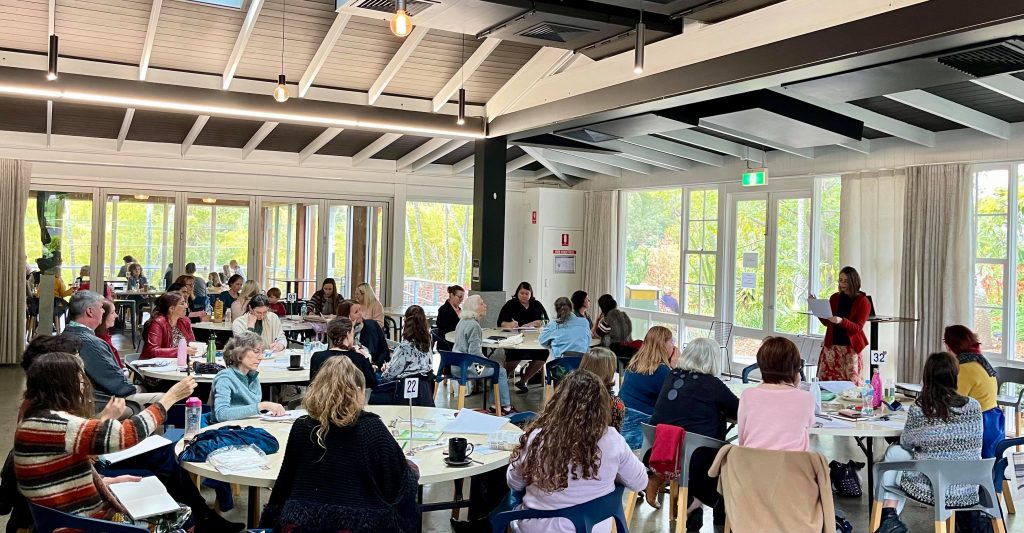
Photo by Maria Parenti
One of the delights of reading is when we feel immersed in a place and time. It is often the specific details the author choses that takes us into that experience.
Today I am going to talk about how you can use drawing as a tool to help you with those details by:
- improving your observation of specific details
- improving your recall of being in a place
- time traveling
If you have a sinking feeling with thoughts like — “I can’t do this!” or “This isn’t for me” — was it about drawing or time travel? We’ve been taught that drawing is as impossible for some of us as time travel is. It’s likely at some point you got the message that your drawing is no good and so it never will be. I acknowledge your experiences with drawing and understand that I could be asking something difficult of you today, so I want to say two things.
Firstly, today is NOT about how well you can draw, it is about how useful drawing can be with the skills you have right now. And secondly, drawing a skill that can be learnt, like driving a car. We won’t all be fabulous artists, just as we won’t all race in the Grand Prix, but that doesn’t mean that driving and drawing aren’t useful. (If this sparks your interest, I always love to give people the book, “Drawing on the Artist Within” by Betty Edwards.)
So, back to what we are doing today… for the next little while I am asking you to approach this time with curiosity. Any time your Special Inner Critic for Drawing pipes up, please acknowledge them and then gently put them aside for the time being.
And if you can draw, great! Please also approach this with curiosity!
Observational Drawing – Why Bother?
Today is about Observational drawing. Remembering this is not about how ‘good’ your drawing is, it is also NOT about making art, NOT about imagination. That’s why I didn’t bring art materials. What you have with you will do the job!
Before I launch off into showing you how drawing can help your observation and recall, it will be good to get a baseline. (1)
Without moving, think about your purse, wallet or keys, or something else you have in your bag or pockets. Your purse or keys are good because you are very familiar with them, right?
Now, without looking at them, draw them with as much detail as you can remember. Draw your specific purse or keys. A place to start might be to consider, “How long is my purse compared to how wide?” You can draw from different angles, open and closed.
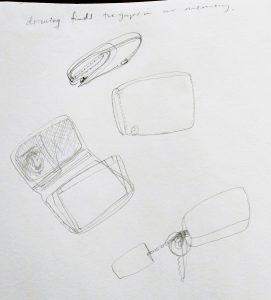
Fiona Glencross West
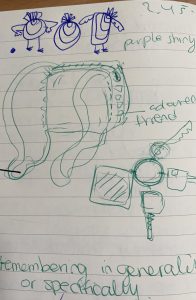
Yvonne Mes
(Dear Reader, have a go yourself! It only takes a minute or two and will help make sense of the rest of this blog.)
Now, get your purse or keys out and see! How did you go?
For (almost?) everyone I’ve tried this exercise with, it has showed up gaps in our recall. Which brings me to:
Understanding Our Own Nature.
We tend to remember in generalities. This is not a bad thing – it is an efficient use of brain space. However, when we are creating stories, we not only need details, but we also need the right details.
e.g., Think about your childhood Christmases…
It’s likely you’ll remember them in general, rather than each one separately and distinctly (except for if there was a Christmas that was different for some reason). However, when writing or drawing a Christmas we need to get specific. “We had a tree with decorations and got presents and had a nice lunch and Gran and Grandpa visited,” is not going to immerse your reader in the way some particular details might. “We made a tree with a branch from the silky oak and decorated it with my paper chains and Mum’s Faberge egg.” (2)
So what has drawing got to do with this?
The First Usefulness of Drawing:
Drawing can help us see where the gaps are in our memories. We think we knew what our purses or wallets looked like but drawing revealed that there was more detail that was unimportant to day to day life but could be important to story-making.
Drawing can also help us see where the gaps are in our imaginations. I often think that I’ve imagined a full scene, but when I actually draw it down, gaps are revealed where my imagination not only hadn’t put anything in there but hadn’t noticed that there was a piece missing.
So, use drawings! Draw your character’s purse (or magic wand or whatever). Draw your action scenes (who is where and when). Draw maps to pin down how far your character has to run to the bakery – is that the same as to the lake? Did you forget that they have to pass the big dog that way?
The Second Usefulness of Drawing:
When we do observational drawing, it helps us to pay strong attention and be specific. We are forced to stop and connect with, absorb, notice, enjoy, experience and be inspired. We see detail and nuance that had been invisible to us before.
A bit more on Understanding Our Own Nature.
We don’t get as much information throughout eyes as we might think. (3) The brain gets some info from the eyes and constructs the rest based on what is expected. Not only that, if some of the info that the brain does receive doesn’t fit what’s expected, it can disregard it. You just won’t see it. (“Where are my keys/socks/add-your-own-here?”)
Again, this isn’t bad. Well, the annoying loss of keys and socks is bad. However, that aside, it isn’t bad, it’s an efficient use of brain power.
But it means that we can walk through our neighbourhood and see nothing new, nothing interesting, nothing intriguing, nothing inspiring, nothing to add life to our writing or illustrating later.
However, drawing can open us up again to seeing. Today we have a double dose because being somewhere novel makes it easier for us to see more.
The Third Usefulness of Drawing:
Observational drawing is building a time machine. The drawing itself will be the door to your time travel. Through seeing, comprehending, choosing and marking down on paper, you create the ingredients for better recall of detail. Details that can help you take your reader into your story.
The Fourth Usefulness of Drawing:
Time travel! I was going to demonstrate this by showing you the drawings you did last week and let you experience how, just by seeing the drawings, you drop back into the time and place you were when you made them. You were going to recall a great deal more than what the scribbly lines can show anyone else. From this rich recall you can create!
But I messed up and only brought my Travel Forward Time Machine, so we’re going to time travel forwards instead. We will make some drawings now and, in a week, or month, when you look at them, I want to hear about your experiences.
By the way, this is not just my own crazy experience. Others have written about it, so I have good hope it will work for you too.
(Before I go on, I want you to check in and see how the thoughts and feelings about drawing are going. Do you need to set them aside again?)
Remember, the type of drawing we we’ll be doing is not about fabulous draughtsmanship, not about making Art. It’s just a tool to enable you to deep dive into your recall. To deep dive into recall next week or month, we need to deep dive into observation today.
Now we’ll do some drawing.
This time-travel drawing works best if you go slowly and be specific.
Compare this drawing… (4)
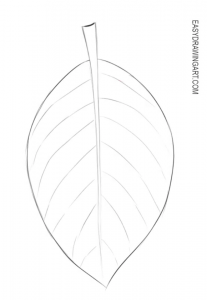
Leaf – Drawing Easy Art
with this one… (5)
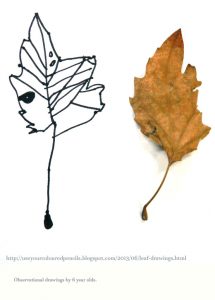
Use Your Coloured Pencils – blogspot
Or this one… (6)
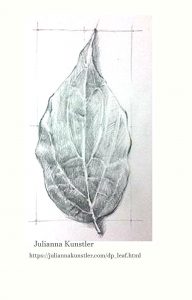
Julianna Kunster (6)
Consider which drawings show the deeper focus and observation? Which one would make the better time machine, do you think?
Images are very efficient communicators of a lot of information. Consider how much you understood about the leaves in the second and third drawings in a blink of an eye. One is by a skilled drawer; the other is a first observational drawing by a six year old. They both have the power of observation embedded in them.
Today we are in these wonderful gardens. Drawing can help us to return here in our time machines. We don’t need to get inspiration for a setting, scene or character today, but you might! Today we are about adding to your collection of detail, nuance and understanding which later can bubble up when you need it.
Unfortunately, we don’t have time for much of a drawing lesson today, but I’d like to give you process to work with. Feel free to go ahead your own way, remembering we are looking for specific, accurate observations.
(How are those feelings about drawing now? Time to set them aside?)
We are going to draw what you see out a window.
Step 1
Compare the width and height of the window. These are the borders of your drawing.
This is where you see artists doing this: pencil held out, arm straight out, one eye closed. Measure the longer side of the window against your pencil. Then measure the shorter side. Is it half the long side? Two thirds? Draw a rectangle on your paper with the same proportions.
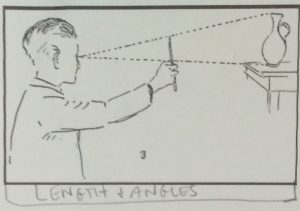
Step 1 – Measure with pencil (7)
Imagine dividing the window border into quarters along each side, and then mark the same quarters on your drawing border. Use these to help you judge the position of the part you are placing in your border.
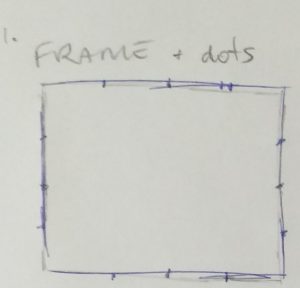
Divide the boarder into quarters.
Step 2
Look at your scene. What are the big parts? What are the most obvious parts?

Japanese Gardens at Mt Coo-tha (8)
Step 3
Choose one part to start with. Where does it sit within your border?
Lightly mark in the edges of that part within your border.
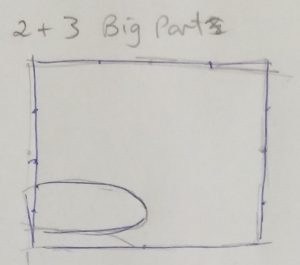
Step 2 & 3
Step 4
Choose another obvious part. Go through a similar assessment. Where does it sit in relation to the border? Where does it sit in relation to the part you’ve already drawn?
Lightly mark it in on your drawing.
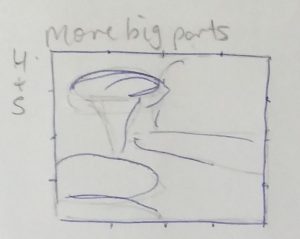
Step 4 & 5
Step 5
Do step 4 until you have all the major parts marked in.
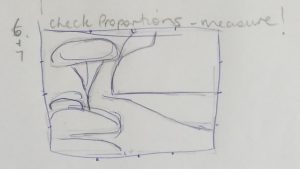
Step 6 & 7
Step 6 Check your proportions with the actual scene again. Lightly make adjustments.
Step 7 When you are happy enough with the proportions, you can darken the lines you want to keep. (I’ve been darkening the lines as I go with blue pen, just so they show up in the pictures.)
Step 8
Look at your scene again and choose a smaller part that interests you. Where does it sit in relation to the border? In relation to your drawing?
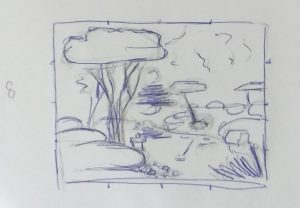
Step 8
Step 9
Continue working this way until you have drawn all the things that you want to capture in your creative bank.
When you don’t happen to have a window frame handy, make your own frame. You can do this with a cardboard frame or your hands like this…
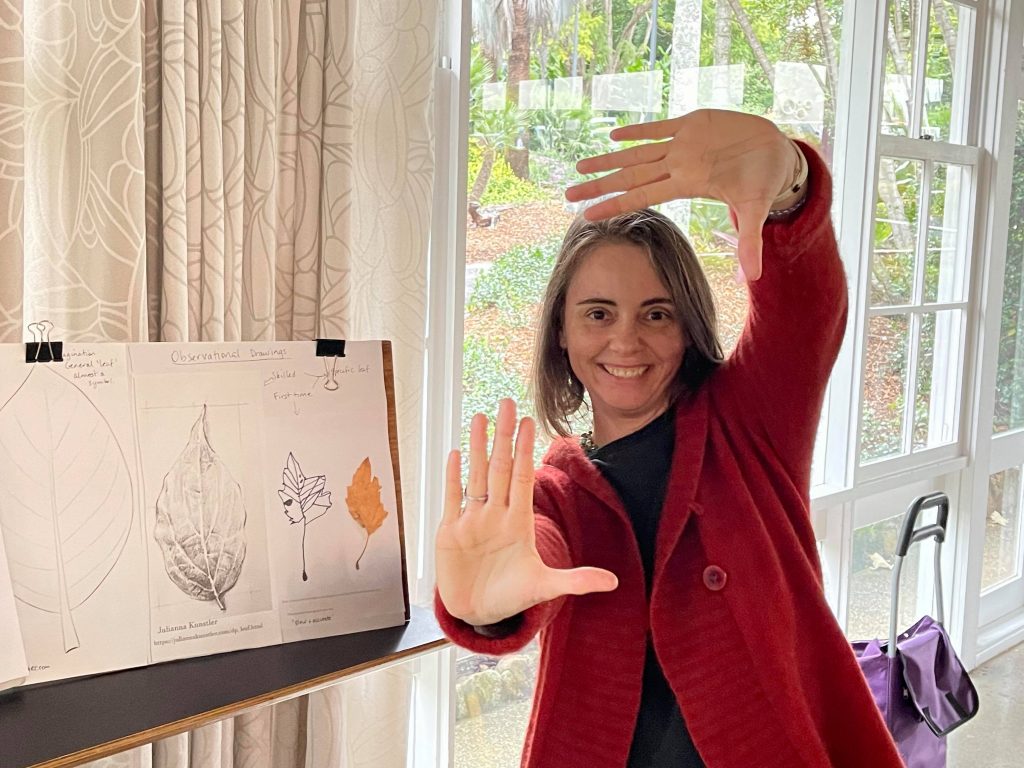
Justine Lawson – photo by Maria Parenti
For comparison, take a photo of a different window/scene for your future self to see how you absorb different information by drawing compared to taking a photo.
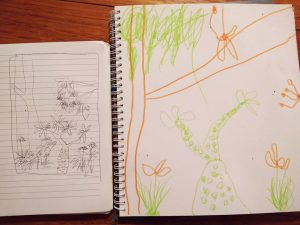
Alison and Reuben Rutstein
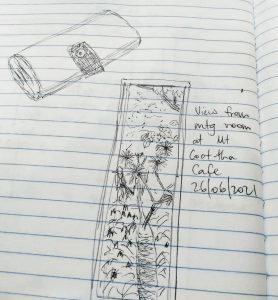
Annaleise Byrd
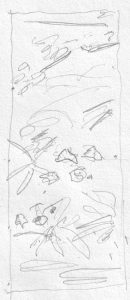
Cecilia Adams
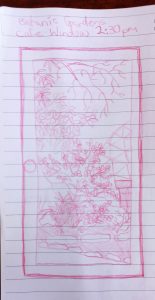
Renata Clarke
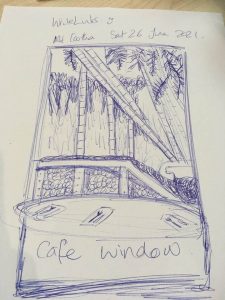
JM Wisbey
So, in conclusion, this type of Observational Drawing:
- shows the gaps and generalisations in our memory and imaginations
- creates a situation for greater depth of observation, specifics rather than generalisations
- inputs info for greater recall later
- allows you to time travel back and recall so much more of the time and place than just what you put on the page
Sometime later…
At our next Write Links meeting I asked those who did this workshop to take a look back at their drawings and tell me their responses. A couple of people shared that it worked! I hope that you, too will find this interesting and useful!
A big thank you to Fiona Glencross West, Yvonne Mes, Alison and Reuben Rutstein, Anna Byrd, Cecilia Adams, Renata Clarke and JM Wisbey for sharing your drawings in this blog.
Click here to read Renata Clarke’s blog post on our Mt. Coo-tha meeting and writing/drawing activation.
Resources and Links:
General
“Drawing on the Artist Within” Betty Edwards
https://nature-mentor.com/nature-journaling/
https://www.paperbarkwriter.com/nature-journaling/ (Paula Peeters has a downloadable book on her website and does nature journaling sessions around Brisbane. (I haven’t been to one, yet))
“The Laws Guide to Nature Drawing and Journalling” by John Laws
Urban Sketching 101: How To Draw Your Surroundings with Peggy Dean https://youtu.be/Cpw6PL2s0GA
Chit chat to begin. 6Min15 – intro and attitude. Instruction starts 11min30.
Footnotes
(1) My own idea. I haven’t heard of anyone else doing this. If you have, I’m very interested in hearing about it!
(2) https://www.abc.net.au/radionational/programs/sundayextra/how-will-you-remember-the-pandemic/13373932 (eg of Christmases)
(3) https://www.youtube.com/watch?v=BP1gCG8_5uQ James Gurney, 5min 50
(4) https://easydrawingart.com/how-to-draw-a-leaf/
(5) http://useyourcolouredpencils.blogspot.com/2013/06/leaf-drawings.html
(6) https://juliannakunstler.com/dp_leaf.html
(8) https://commons.wikimedia.org/wiki/File:Japanese_Gardens_at_Mt_Coot-tha.jpg
Comments
Sorry, the comment form is closed at this time.




Pingback: Write Links Meets in Person – At Mount Cootha Botanic Gardens! – Write Links